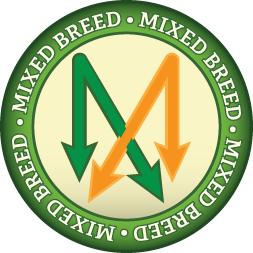
-
Activity Level:
moderate
-
Shedding Level:
moderate
-
Grooming Level:
moderate
-
Trainability:
high
-
Good for Novice Owners:
moderate
-
Adaptability:
high
-
Kid/Pet Friendly:
often
-
Prey Drive:
low
-
Watchdog:
very alert
- Average Size: Giant
- Average Lifespan: 7-10 years
Great Dane Mix Dog Breed Information
Overview
Temperament
Adaptability
Health
Owner Experience
Grooming
Activity Level
Size
Life Span
A Great Dane Mix is a cross between a Great Dane and another dog breed. A mix can take on any combination of traits from their parents, so it’s important to discuss both parent breeds with the breeder. Should a Great Dane Mix take after their Dane parent, they will grow to be a huge, lovable dog that is gentle, affectionate, and playful.
Great Danes are notorious for their size, but are also known for their sweet, loving, and affectionate personalities. These big dogs love to cuddle and will attempt to be lap dogs. They also tend to get along well with children, other dogs, and other pets. Although they are protective of their families, they will warm up to strangers once they have been introduced as long as they have been properly socialized.
The other parent breed will introduce their own set of quirks and traits that could affect temperament. So, you do want to ask the breeder about them. You can also meet the mother in person to get a sense of her temperament and the behavior she is modeling for her puppies. The breeder should have started to socialize a puppy and train them, but it is up to you to continue doing that once you get your puppy home.
Although they are huge dogs, Great Danes are also highly adaptable. They’re one of the best large dog breeds for small homes because they can adapt well to small homes as well as large ones and can even do well in apartments as long as there is enough room for this large dog to move around.
They are sensitive to cold and don’t like to be left alone for long periods of time. The other parent breed may have some traits that affect adaptability in a Great Dane Mix, so you do want to ask the breeder about them.
Although a mixed-breed dog can sometimes be healthier than a purebred dog, it’s not a guarantee. A mix could inherit none of the conditions common to their parent breeds, but they could also inherit those common to one or both of them.
From the Great Dane side, potential health concerns to be aware of in a Great Dane Mix include hip dysplasia, elbow dysplasia, heart disease, and bone cancer. Reputable breeders will screen their dogs to prevent passing issues to puppies, so make sure you are asking about the health history of both of the parents.
As a large, barrel-chested breed, Great Danes, and potentially a Great Dane Mix, are at risk for bloat. Bloat in dogs can become dangerous quickly if gastric torsion occurs, so it’s important to know how to reduce the risk and also to know symptoms.
Great Danes are generally eager to please, intelligent, and easy to train. Their size and exuberance as puppies can be a challenge for first-time dog owners, but they tend to be highly trainable dogs.
The other parent breed could make a Great Dane Mix more difficult to train. If that is the case, you will want to be prepared to enroll in puppy training classes. These classes can be a good idea even if you don’t need them for training because they also offer socialization opportunities and can help strengthen the bond you have with your puppy.
A Great Dane Mix could inherit a coat that is just like one of their parents or one that is truly a mix of both. Should they inherit the Great Dane coat, they will shed year-round, require brushing weekly or a few times a week, and need an occasional bath.
In addition to coat care, you also need to care for your Great Dane Mix’s nails, ears, and teeth. Nail trims once or twice a month are usually enough and weekly ear checks can help prevent ear infections. Daily use of an enzyme toothpaste or brushing every day is an ideal start for doggie dental care and can help prevent painful diseases later in life.
Although a Great Dane can be energetic while they are playing, they tend to sit in a low to moderate activity range. Daily walks plus some playtime are usually enough for this breed, but they may be up for more if you are.
You do want to keep things low-impact until puppies finish growing to prevent damage to developing bones and joints. The other parent could affect the potential activity range to expect in a Great Dane Mix, so you want to make sure you ask the breeder about them and prepare for whatever potential range that could be.
A fully-grown Great Dane usually stands 30-34 inches tall and weighs 100-200 pounds. The other parent breed can have a big effect on this, especially if they are the mother.
Although it’s not a guarantee, you can meet the mother in person to get an idea of what size to expect in a fully-grown Great Dane Mix.
Great Danes generally live for 7-10 years. The other parent breed could affect this slightly, but you should be able to expect a similar life span in a Great Dane Mix.









